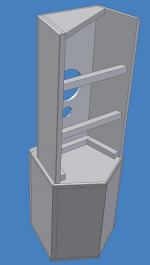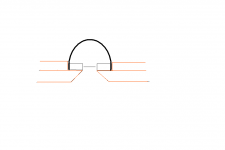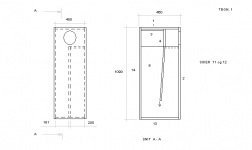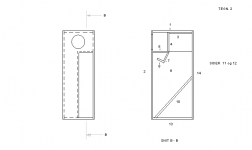Hopefully at some point in the future Martin King will take an interest as if anyone can crack the math he can.
I tried, once, to run a wave sim on the K-vent, all i got was gibberish, however that was the box type and my program is a more dedicated "expanding vent".
But i had good results and a very flat response with an excellent loading curve with a more TQWT with the K-vent. This led to the use of the mouth curves that i now use as properly designed they can produce a more spherical wave and help a bit with the TL ripple.
ron
I tried, once, to run a wave sim on the K-vent, all i got was gibberish, however that was the box type and my program is a more dedicated "expanding vent".
But i had good results and a very flat response with an excellent loading curve with a more TQWT with the K-vent. This led to the use of the mouth curves that i now use as properly designed they can produce a more spherical wave and help a bit with the TL ripple.
ron
Ah! I was wondering if you'd taken a look at them Ron. No offense (the kind of math you guys can do makes my eyes water) -I wasn't sure how specialised your own software was toward horns etc. Interesting.
BTW, out of curiosity, do curved mouths continue to retain their advantage for 1/2 wave tuned horns as well as shortened ones?
All the best
Scott
BTW, out of curiosity, do curved mouths continue to retain their advantage
All the best
Scott
BTW, out of curiosity, do curved mouths continue to retain their advantage for 1/2 wave tuned horns as well as shortened ones?
They sure do. The main advantage is a more spherical wavefront , which is natural in nature, by correcting for an out of aspect ratio mouth.Making the BIB a bit taller and including a "scoup" type mouth would refine the Fc wavefront and provide a bit more directivity. Look at the wavefront in a upward firing BIB. It fires directly up to the roof and that being a perfect reflector( 90 deg to the wavefront,energy being dependant on the acoustical impedance mismatch) there is a reflected wavefront with a given energy, dependant on frequency and distance, being reflected back to the mouth. This energy is compressed n its trip back to the driver turning a low pressure wavefront back to a high pressure wavefront, or the reverse of a horn action. This wave arrives in a random timed phase back to the driver causing distortion of the wave that the driver is producing by a pressure differential actopn. Remember that a reflected wave can be considered as a secondary transducer with some different prameters than was originally produced.
IMO like a F1 car its not any one singular item that makes the end performance but a collection of items that combine.
ron
They sure do. The main advantage is a more spherical wavefront , which is natural in nature, by correcting for an out of aspect ratio mouth.Making the BIB a bit taller and including a "scoup" type mouth would refine the Fc wavefront and provide a bit more directivity. Look at the wavefront in a upward firing BIB. It fires directly up to the roof and that being a perfect reflector( 90 deg to the wavefront,energy being dependant on the acoustical impedance mismatch) there is a reflected wavefront with a given energy, dependant on frequency and distance, being reflected back to the mouth. This energy is compressed n its trip back to the driver turning a low pressure wavefront back to a high pressure wavefront, or the reverse of a horn action. This wave arrives in a random timed phase back to the driver causing distortion of the wave that the driver is producing by a pressure differential actopn. Remember that a reflected wave can be considered as a secondary transducer with some different prameters than was originally produced.
IMO like a F1 car its not any one singular item that makes the end performance but a collection of items that combine.
ron
Another one falls for the Basszilla style box. Not that there's anything wrong with that of course.  I suspect you might set a little too much store by group delay though.
I suspect you might set a little too much store by group delay though.
Ron, that's very interesting. I assume the effects continue when they're corner-loaded too, albeit possibly reduced somewhat? Do you mind if I PM you for some advice re this topic?
Cheers
Scott
Ron, that's very interesting. I assume the effects continue when they're corner-loaded too, albeit possibly reduced somewhat? Do you mind if I PM you for some advice re this topic?
Cheers
Scott
Many years ago I played with fullrange ribbons - sounded very good but hard to controll
it was before neo magnets were available so they were quite hard to drive
Now I will try them smaller, without heavy plastic carrier
One will be 15 x 25 mm, and a smaller one 8 x 12
I have the magnets so its a point of no return
I have a small amp that will do low impedanse easily, so I hope ribbons will be effective enough to do with a small series resistor -otherwise trafos may be needed
Might not be perfect, but great fun
BTW .. I think that many people doing multiway dipole, simply forget that tweeter also need to be dipole
BohlenderGraebender has a NEO-3/RAW which is pure dipole and is said to sound quite good
it was before neo magnets were available so they were quite hard to drive
Now I will try them smaller, without heavy plastic carrier
One will be 15 x 25 mm, and a smaller one 8 x 12
I have the magnets so its a point of no return
I have a small amp that will do low impedanse easily, so I hope ribbons will be effective enough to do with a small series resistor -otherwise trafos may be needed
Might not be perfect, but great fun
BTW .. I think that many people doing multiway dipole, simply forget that tweeter also need to be dipole
BohlenderGraebender has a NEO-3/RAW which is pure dipole and is said to sound quite good
LOL, this is not especially Basszilla box, what I want isn't Big and Loud, but group-delay free, low-distorsion, and clean impulse response bass. Guess what : I can only get 100dB from these subs at 20Hz...
That's true, only one part of the system will be dipole : the midrange. As I cannot afford a second tweeter, maybe I will end up sealing up everything. Anyway, the open baffle will be massively damped. I have built small open baffles for F120A drivers, and they only sounded good if damped on the rear.
tinitus : I'd be curious to see how your DIY ribbons work ! It's truly interesting !
That's true, only one part of the system will be dipole : the midrange. As I cannot afford a second tweeter, maybe I will end up sealing up everything. Anyway, the open baffle will be massively damped. I have built small open baffles for F120A drivers, and they only sounded good if damped on the rear.
tinitus : I'd be curious to see how your DIY ribbons work ! It's truly interesting !
youyoung21147 said:As I'm not a fan of high impedance amps (that makes speaker sound boomy), I prefer to use either the computer's equalizer or a shelved lowpass buffer. Not a fan of passive notch filters : they reduce the damping factor in the midrange.
I'm not a fan of rear-firing vents either : it causes problems with the rear wall, adds group delay and makes the sound less natural.
I designed this speaker almost two years ago, and if I had some new FX120 drivers to use, I would probably put them in sealed or open baffle, then cross to a sealed subwoofer. More SPL, less distorsion and cleaner sound.
Greets!
Not when the speaker's well damped, as my alignment is.
Hmm, please explain to me how a passive shelving ckt. with a HF by-pass cap designed to work in the driver's BW below its mass corner (box controlled) will lower its DF in its mass controlled BW.
You're right, you need to either know what you're doing or willing to experiment with tuning if a rear vent is used in a near wall or corner position, but the norm is to have them out well away from any boundaries for max sound-staging, so having a near/at the floor rear firing vent is beneficial since it dissipates any potential vent noise from audibly comb filtering with the driver's response.
I'm with you, when appropriate, I'm very vocal about limiting so called 'fullrange' drivers to wide BW mids in at least a three way (and the way I normally used them), but this isn't what this forum is all about, so based my response on yours.
GM
ronc said:This led to the use of the mouth curves that i now use as properly designed they can produce a more spherical wave and help a bit with the TL ripple.
Greets!
Right, too small a horn mouth is ~acoustically equivalent to a too small baffle, so odd shapes that average out its standing waves helps a bunch if there's not enough room for appropriately large, rolled over flanges. That, or rim the mouth with the appropriate density acoustic foam to mimic the large flares, like done on some Peavy and the old Urei studio monitor HF horns.
GM
Scottmoose said:I suspect you might set a little too much store by group delay though.
Greets!
Ya think!
GM
ronc said:Now if i can convince yall to include a filter chanber (LOL).
ron
Greets!
'Baby steps'.
GM
GM said:Ya think!I've built many alignments with what I now know had enough group delay to indicate they should have rung like a ship's bell, yet folks claimed they were 'tight' to the point of being too 'dry' sounding/not 'musical', which to me means they weren't distorting enough for their 'tastes', but I'm done 'fighting' this no-win 'battle'.
No argument from me -what I ws trying to say (not very well) is that I've seen people get so obsessed by it in the past that they loose site of other aspects of the design in the process. Depends on the extreme's it's taken to I guess.
GM said:'Baby steps'.I imagine we'll get there eventually for the folks who are willing to invest the time required to learn how to get to the next level of pipe horn performance. For most though, the BIB is good enough if tuned low enough. It's kind of ironic in a way, me and TC had discussed pipe horns a bit and I had decided to start getting folks thinking about them when I posted my 'EATP' response to Hitsware's 1/2 WL pipe queries on the original FR forum, but MJK ~shut me down before I had a chance to develop it, so TC went ahead and built a pair, which got ~trashed based on sims using MJK's new WS. At least he lived long enough to be vindicated.
Out of interest Greg, could you go a little further into your original EATP response / suggestion? I remeber you mentioning it before, but I forgot to ask about it at the time, and the old FR forum archives are dead at present. Pity about what happened initially -as you say, at least TC saw their popularity increase.
You're both right of course -time to look into more advanced takes on the pipe horns. It was your idea for a BIB with additional tapped horn boost that finally pushed me over the edge Greg -I was going to emulate you in a smaller way with Monacor drivers (no room for 8in versions
Cheers guys
Scott
Greets!
Hmm, I see I got to rambling way OT, so I'll address all this in my response to your PM. WRT the tapped horn driver location though, if I understand the alignment correctly it will depend on the driver's specs, XO point, and taper ratio, ergo no set position unless the driver is tailored to a basic TH design. WC's experience appears to support my POV, but I haven't built any, so may not be interpreting his results correctly though (click on 'tapped horns' link): http://diy.cowanaudio.com/
GM
Hmm, I see I got to rambling way OT, so I'll address all this in my response to your PM. WRT the tapped horn driver location though, if I understand the alignment correctly it will depend on the driver's specs, XO point, and taper ratio, ergo no set position unless the driver is tailored to a basic TH design. WC's experience appears to support my POV, but I haven't built any, so may not be interpreting his results correctly though (click on 'tapped horns' link): http://diy.cowanaudio.com/
GM
GM : I was talking about an active shelving lowpass filter to compensate for baffle step diffraction. I'm not hot when it's about placing components between the amp and the speakers, especially when driven by a chip amp (bridged LM4780 in my case).
That's right we are in the fullrange forum, so I understand very well that passive solutions are by far prefered by most here because of their apparent simplicity.
That's right we are in the fullrange forum, so I understand very well that passive solutions are by far prefered by most here because of their apparent simplicity.
- Status
- This old topic is closed. If you want to reopen this topic, contact a moderator using the "Report Post" button.
- Home
- Loudspeakers
- Full Range
- Inspiration : a TQWT for Fostex FX120 and Fe127e

 200 liter closed with matrix
200 liter closed with matrix

